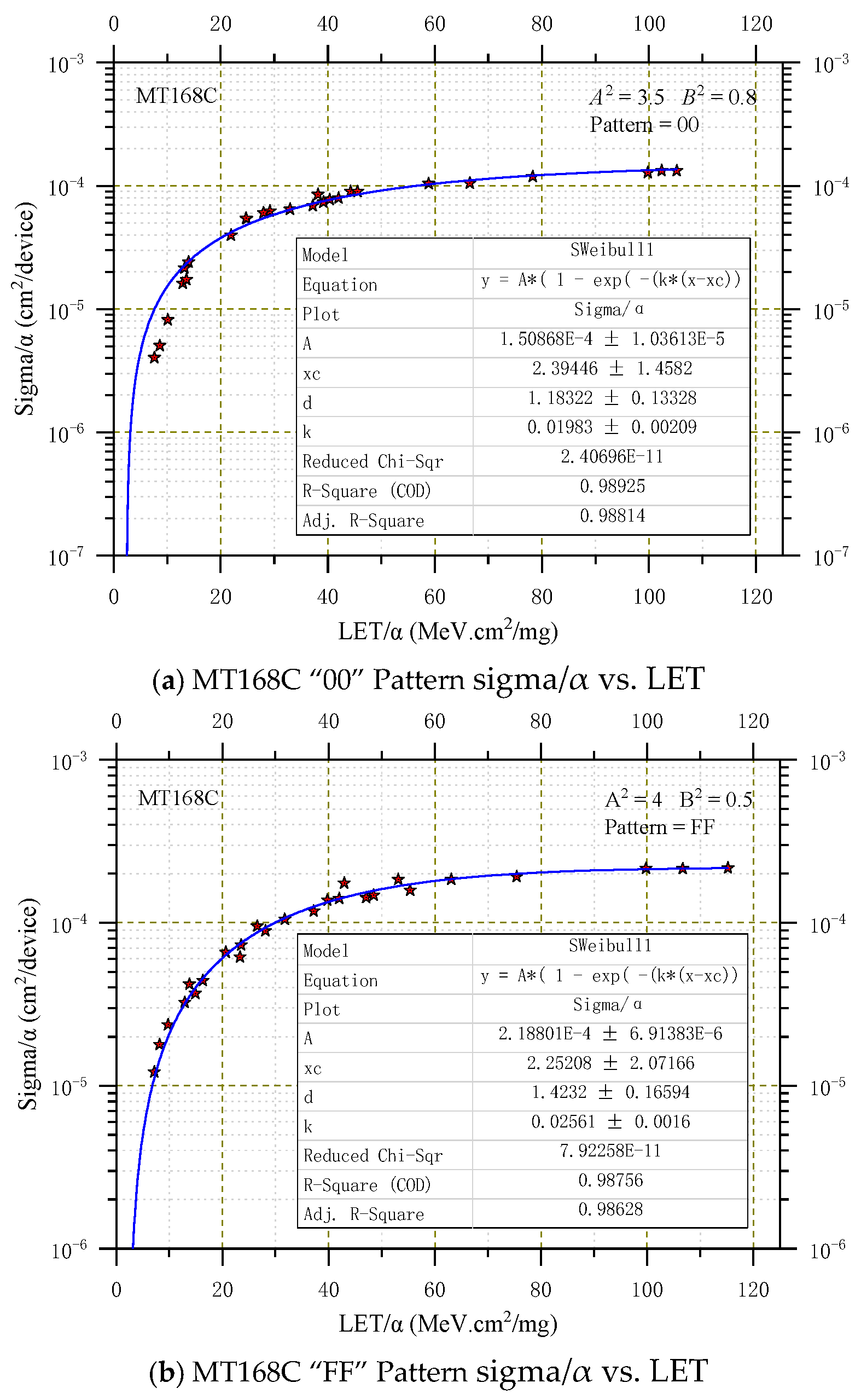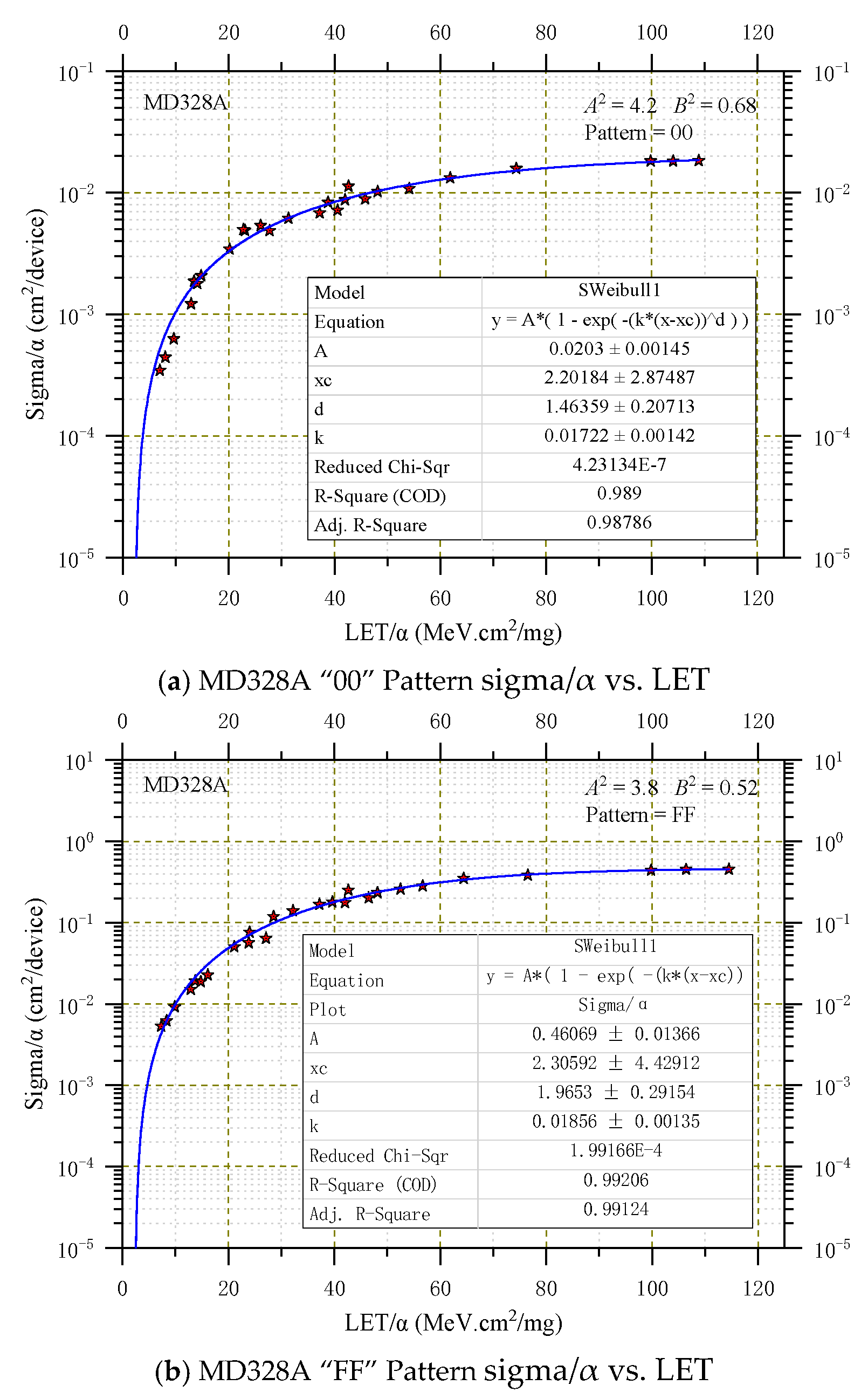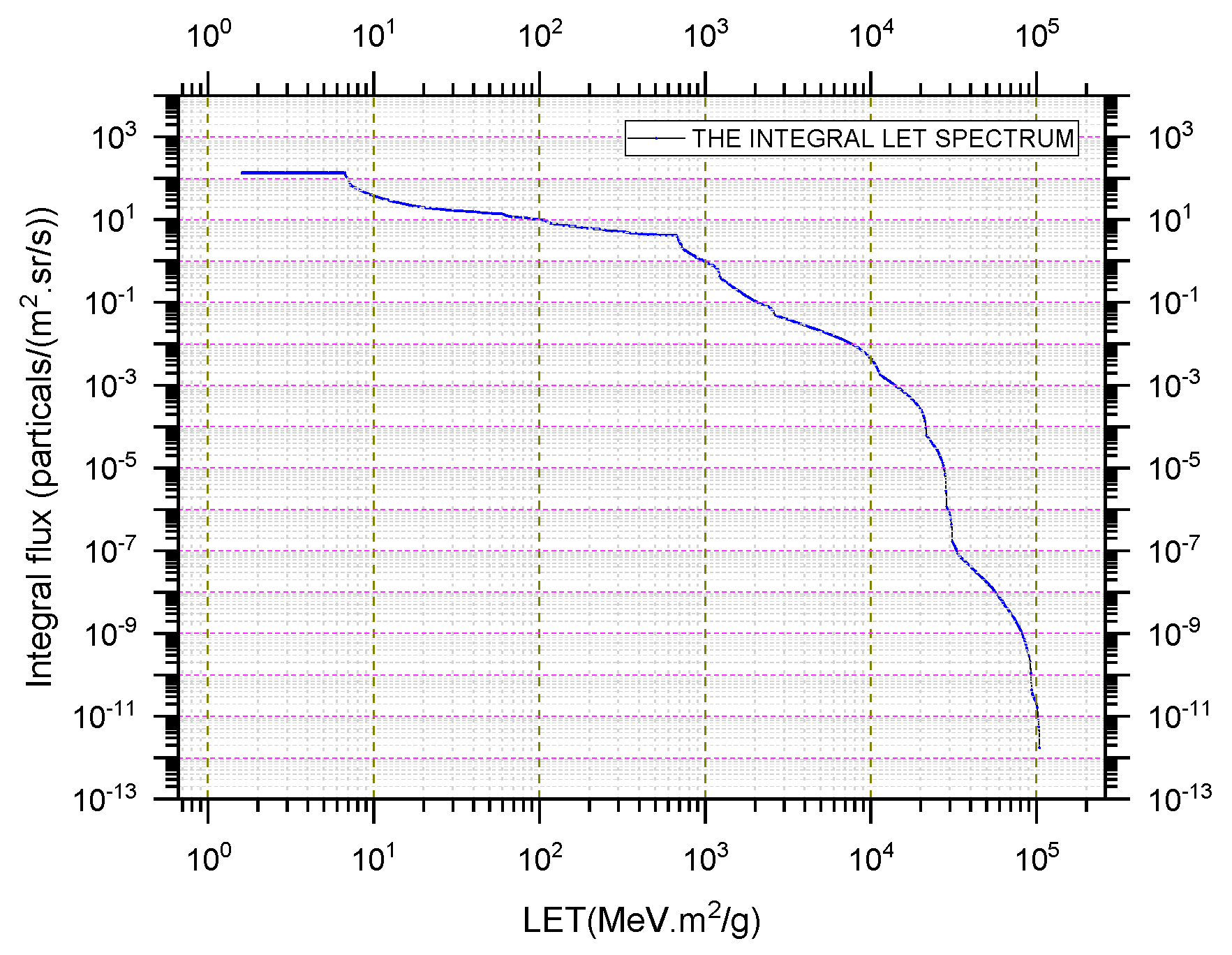Research on a General SER Rate Prediction Model Based on a Set of Configuration Parameters Related to SER
Abstract
1. Introduction
2. Mathematical Foundations of Rate Prediction
2.1. General Single-Event Effect Rate Equation
2.2. The Projected Cross-Sectional Area
- (1)
- For effects that essentially have unit probability , such as SEUs induced by highly ionizing heavy ions, the size of the SER cross-section is equal to the projected area of the interaction volume in the direction.
- (2)
- For integrated circuits constructed from basic units with the same SER Rate (or sensitivity), the reliability distribution of the projected cross-section can be physically characterized using the Weibull function, owing to the reliability of previous data processed using this function. At this point, the exact value of the configuration parameter ξ in Equation (17) can be determined through the best Weibull fit of . Of course, for other cases when circuits are specified, the projected cross-section must also correspond to some exact distribution function, although it does not necessarily have to satisfy Weibull distribution.
- (3)
- During high-energy particle irradiation, the circuit exhibits a certain degree of saturation characteristics, meaning . At this point, the cross-section is equal to the projected area of the interaction volume/world surface in the direction. Of course, can also be greater than 1, indicating a supersaturation characteristic, which corresponds to a situation where one incident particle induces multiple effects, such as Multiple Bit Upsets in SEU.
- (4)
- When the particle energy and type are fixed, the size of the projected area is determined by the configuration parameter set ξ related to the effects on the circuit and the initial position parameters of the incident particles. Therefore, if the position of the incident particles is fixed or unchanged, the distribution of can be used to infer the consistency of the configuration parameter set ξ related to SER, providing important performance evaluation means for radiation-hardened integrated circuit designers.
- (5)
- Equations (12) and (13) provide important bases for evaluating the radiation-hardened performance of circuits in engineering. In practice, the effect cross-section of the circuit can be directly calculated based on test data using the definition of Equation (12), such as the SEU cross-section, single-event transient cross-section, single-event burnout cross-section, etc. Then, according to Equation (13), the projected area of the interaction volume within the circuit in different directions can be calculated, which represents the overall radiation-hardened performance of the circuit.
- (6)
- The derivation process of Equations (12) and (13) does not require specifying the shape of the interaction volume. The effect rate is only related to the projected area of the interaction volume and the effect probability; thus, this model has good universality.
2.3. SER Rate Prediction
3. Example Applications of Rate Prediction
3.1. Heavy Ion Experiment
3.2. Heavy Ions Results
3.3. SEU Prediction
4. Conclusions
Author Contributions
Funding
Data Availability Statement
Conflicts of Interest
References
- Kim, S.H.; Jo, Y.D.; Ryu, J.; Hong, M.J.; Kang, B.C.; Kim, J.B. Effects of the total dose and duration of γ-irradiation on the growth responses and induced SNPs of a Cymbidium hybrid. Int. J. Radiat. Biol. 2020, 96, 545–551. [Google Scholar] [CrossRef] [PubMed]
- Aloisio, R. Ultra High Energy Cosmic Rays an overview. J. Phys. Conf. Series. 2023, 2429, 012008. [Google Scholar] [CrossRef]
- Oh, B.; Lisy, C.; Tran, G.U.; Lohmeyer, W.; Campola, M.; Palo, S. CubeSat Radiation Hardness Assurance Beyond Total Dose: Evaluating Single Event Effects. In Proceedings of the Small Satelite Conference 2022, Utah State University, Logan, UT, USA, 6–11 August 2022. [Google Scholar]
- Binder, D.; Smith, E.C.; Holman, A.B. Satellite anomalies from galactic cosmic rays. IEEE Trans. Nucl. Sci. 1975, 22, 2675–2680. [Google Scholar] [CrossRef]
- May, T.C.; Woods, M.H. Alpha-particle-induced soft errors in dynamic memories. IEEE Trans. Electron Devices 1979, 26, 2–9. [Google Scholar] [CrossRef]
- Petersen, E.L. Parametric and Threshold Studies of Single Event Sensitivity. IEEE Trans. Nucl. Sci. 2007, 54, 1392–1405. [Google Scholar] [CrossRef]
- Adams, J.H., Jr. Cosmic Ray Effects on Microelectronics; Part 4; DTIC: Fairfax County, VA, USA, 1986. [Google Scholar]
- Binder, D. Analytic SEU rate calculation compared to space data. IEEE Trans. Nucl. Sci. 2002, 35, 1570–1572. [Google Scholar] [CrossRef]
- Petersen, E. The SEU figure of merit and proton upset rate calculations. IEEE Trans. Nucl. Sci. 1999, 45, 2550–2562. [Google Scholar] [CrossRef]
- Bendel, W.L.; Petersen, E. Proton Upsets in Orbit. IEEE Trans. Nucl. Sci. 2007, 30, 4481–4485. [Google Scholar] [CrossRef]
- Reed, R.A.; McNulty, P.J.; Beauvais, W.J.; Abdel-Mader, W.G.; Stassinopoulos, E.G.; Barth, J. Simple algorithm for predicting proton SEU rates in space compared to the rates measured on the CRRES satellite. IEEE Trans. Nucl. Sci. 1995, 41, 2389–2395. [Google Scholar] [CrossRef]
- Pickel, J.C.; Blandford, J.T. Cosmic-Ray-Induced Errors in MOS Devices. IEEE Trans. Nucl. Sci. 1980, 27, 1006–1015. [Google Scholar] [CrossRef]
- Petersen, E.L.; Langworthy, J.B.; Diehl, S.E. Suggested Single Event Upset Figure of Merit. IEEE Trans. Nucl. Sci. 1983, 30, 4533–4539. [Google Scholar] [CrossRef]
- Bradford, J.N. Geometric Analysis of Soft Errors and Oxide Damage Produced by Heavy Cosmic Rays and Alpha Particles. Nucl. Sci. IEEE Trans. 1980, 27, 941–947. [Google Scholar] [CrossRef]
- Bendel, W.L. Length Distribution of Chords Through a Rectangular Volume; NRL Memo Rep 5369; U.S.; Naval Research Lab.: Washington, DC, USA, 1984. [Google Scholar]
- Tylka, A.J.; Adams, J.H.; Boberg, P.R.; Brownstein, B.; Dietrich, W.F.; Flueckiger, E.O.; Petersen, E.L.; Shea, M.A.; Smart, D.F.; Smith, E.C. CREME96: A revision of the cosmic ray effects on micro-electronics code. IEEE Trans. Nucl. Sci. 1997, 44, 2150–2160. [Google Scholar] [CrossRef]
- Petersen, E. Soft error results analysis and error rate prediction. In Proceedings of the IEEE Nuclear and Space Radiation Effects Conference Short Course, Tucson, AZ, USA, 14–18 July 2008; Available online: http://ieee-npss.org/wp-content/uploads/2014/03/2008-NSREC.pdf (accessed on 1 June 2018).
- Petersen, E. Single event analysis and prediction. In Proceedings of the IEEE Nuclearand Space Radiation Effects Conference (NSREC) Short Course, Tucson, AZ, USA, 14–18 July 2008. [Google Scholar]
- Petersen, E.L. Single-Event Data Analysis. IEEE Trans. Nucl. Sci. 2008, 55, 2819–2841. [Google Scholar] [CrossRef]
- Reed, R.A.; Weller, R.A.; Mendenhall, M.H.; Lauenstein, J.M.; Warren, K.M.; Pellish, J.A.; Schrimpf, R.D.; Sierawski, B.D.; Massengill, L.W.; Dodd, P.E.; et al. Impact of Ion Energy and Species on Single Event Effects Analysis. IEEE Trans. Nucl. Sci. 2008, 54, 2312–2321. [Google Scholar] [CrossRef]
- Montes, E.J.; Reed, R.A.; Pellish, J.A.; Alles, M.L.; Schrimpf, R.D.; Weller, R.A.; Varadharajaperumal, M.; Niu, G.; Sutton, A.K.; Diestelhorst, R.; et al. Single Event Upset Mechanisms for Low-Energy-Deposition Events in SiGe HBTs. IEEE Trans. Nucl. Sci. 2008, 55, 1581–1586. [Google Scholar] [CrossRef]
- Kobayashi, A.S.; Ball, D.R.; Warren, K.M.; Reed, R.A.; Haddad, N.; Mendenhall, M.H.; Schrimpf, R.D.; Weller, R.A. The effect of metallization Layers on single event susceptibility. IEEE Trans. Nucl. Sci. 2006, 52, 2189–2193. [Google Scholar] [CrossRef]
- Howe, C.L.; Weller, R.A.; Reed, R.A.; Mendenhall, M.H.; Schrimpf, R.D.; Warren, K.M.; Ball, D.R.; Massengill, L.W.; LaBel, K.A.; Howard, J.W.; et al. Role of heavy-ion nuclear reactions in determining on-orbit single event error rates. IEEE Trans. Nucl. Sci. 2006, 52, 2182–2188. [Google Scholar] [CrossRef]
- Dodd, P.E.; Schwank, J.R.; Shaneyfelt, M.R.; Felix, J.A.; Paillet, P.; Ferlet-Cavrois, V.; Baggio, J.; Reed, R.A.; Warren, K.M.; Weller, R.A.; et al. Impact of Heavy Ion Energy and Nuclear Interactions on Single-Event Upset and Latchup in Integrated Circuits. IEEE Trans. Nucl. Sci. 2007, 54, 2303–2311. [Google Scholar] [CrossRef]
- Amusan, O.A.; Massengill, L.W.; Baze, M.P.; Bhuva, B.L.; Witulski, A.F.; DasGupta, S.; Sternberg, A.L.; Fleming, P.R.; Heath, C.C.; Alles, M.L. Directional Sensitivity of Single Event Upsets in 90 nm CMOS Due to Charge Sharing. IEEE Trans. Nucl. Sci. 2007, 54, 2584–2589. [Google Scholar] [CrossRef]
- Olson, B.D.; Ball, D.R.; Warren, K.M.; Massengill, L.W.; Haddad, N.F.; Doyle, S.E.; McMorrow, D. Simultaneous single event charge sharing and parasitic bipolar conduction in a highly-scaled SRAM design. IEEE Trans. Nucl. Sci. 2006, 52, 2132–2136. [Google Scholar] [CrossRef]
- Weller, R.A.; Reed, R.A.; Warren, K.M.; Mendenhall, M.H.; Sierawski, B.D.; Schrimpf, R.D.; Massengill, L.W. General Framework for Single Event Effects Rate Prediction in Microelectronics. IEEE Trans. Nucl. Sci. 2009, 56, 3098–3108. [Google Scholar] [CrossRef]
- Petersen, E.L.; Shapiro, P.; Adams, J.H.; Burke, E.A. Calculation of Cosmic-Ray Induced Soft Upsets and Scaling in VLSI Devices. Nucl. Sci. IEEE Trans. 1982, 29, 2055–2063. [Google Scholar] [CrossRef]
- Arfken, G.B.; Weber, H.J. Mathematical Methods for Physicists, 4th ed.; Academic: New York, NY, USA, 1995; p. 84. [Google Scholar]
- Edmonds, L.D. A method for correcting cosine-law errors in SEU test data. IEEE Trans. Nucl. Sci. 2002, 49, 1522–1538. [Google Scholar] [CrossRef]
- Xapsos, M.A. Applicability of LET to single events in microelectronic structures. IEEE Trans. Nucl. Sci. 1992, 39, 1613–1621. [Google Scholar] [CrossRef]
- Heinrich, W. Calculation of LET-spectra of heavy cosmic ray nuclei at various absorber depths. Radiat. Eff. 1977, 34, 143–148. [Google Scholar] [CrossRef]
- Mitchell, A.T.; Khan, I.M.; Wu, M.A. Analog Floating-Gate Memory Manufacturing Process Implementing n-Channel and p-Channel MOS Transistors. US20130221418A1, 29 August 2015. [Google Scholar]
- Shigeki, I. Transistor protective circuit for H-bridge circuit, inverts control signals and input them to gates of P-channel and N-channel transistors, respectively. DE10017481A, 10 October 2000. [Google Scholar]
- Kim, M.H.Y.; Rusek, A.; Cucinotta, F.A. Issues for Simulation of Galactic Cosmic Ray Exposures for Radiobiological Research at Ground-Based Accelerators. Front. Oncol. 2015, 5, 122. [Google Scholar] [CrossRef]
- JESD89B-Revision of JESD89A; Measurement and Reporting of Alpha Particle and Terrestrial Cosmic Ray-Induced Soft Errors in Semiconductor Devices. JEDEC Solid State Technology Association: Arlington, VA, USA, 2021.



| Device | Process | Capacity (Kbits) | Unit Structure | Bias (V) |
|---|---|---|---|---|
| MT168C | 28 nm Bulk silicon CMOS process | 16 × 8 | 6 T | 0.85 |
| MD328A | 28 nm Bulk silicon CMOS process | 32 × 8 | Double DICE | 0.85 |
| Particles | LET | θ | φ | σMT168C | σMD328A | ||
|---|---|---|---|---|---|---|---|
| 00 | FF | 00 | FF | ||||
| F | 4.06 | 0 | 0 | 0.00 | 0.00 | 0.00 | 0.00 |
| Cl | 12.9 | 0 | 0 | 1.62 × 10−5 | 3.24 × 10−5 | 1.22 × 10−3 | 1.52 × 10−2 |
| Ge | 37.2 | 0 | 0 | 6.89 × 10−5 | 1.18 × 10−4 | 6.80 × 10−3 | 1.68 × 10−1 |
| Br | 42 | 0 | 0 | 7.95 × 10−5 | 1.41 × 10−4 | 8.75 × 10−3 | 1.78 × 10−1 |
| Bi | 99.8 | 0 | 0 | 1.28 × 10−4 | 2.16 × 10−4 | 1.82 × 10−2 | 4.41 × 10−1 |
| F | 4.06 | 30 | 0 | 0.00 | 0.00 | 0.00 | 0.00 |
| F | 4.06 | 45 | 0 | 0.00 | 0.00 | 0.00 | 0.00 |
| F | 4.06 | 60 | 0 | 0.00 | 0.00 | 0.00 | 0.00 |
| Cl | 12.9 | 30 | 0 | 1.04 × 10−5 | 3.13 × 10−5 | 8.44 × 10−4 | 1.20 × 10−2 |
| Cl | 12.9 | 45 | 0 | 7.56 × 10−6 | 2.83 × 10−5 | 7.16 × 10−4 | 9.60 × 10−3 |
| Cl | 12.9 | 60 | 0 | 6.82 × 10−6 | 2.19 × 10−5 | 6.39 × 10−4 | 9.39 × 10−3 |
| Ge | 37.2 | 30 | 0 | 7.93 × 10−5 | 1.18 × 10−4 | 6.53 × 10−3 | 1.55 × 10−1 |
| Ge | 37.2 | 45 | 0 | 8.09 × 10−5 | 1.16 × 10−4 | 7.89 × 10−3 | 1.19 × 10−1 |
| Ge | 37.2 | 60 | 0 | 6.73 × 10−5 | 1.19 × 10−4 | 6.33 × 10−3 | 8.93 × 10−2 |
| Br | 42 | 30 | 0 | 8.23 × 10−5 | 1.39 × 10−4 | 8.25 × 10−3 | 1.83 × 10−1 |
| Br | 42 | 45 | 0 | 9.04 × 10−5 | 1.51 × 10−4 | 8.64 × 10−3 | 9.90 × 10−2 |
| Br | 42 | 60 | 0 | 9.25 × 10−5 | 1.11 × 10−4 | 9.15 × 10−3 | 9.94 × 10−2 |
| Bi | 99.8 | 30 | 0 | 1.51 × 10−4 | 2.54 × 10−4 | 2.11 × 10−2 | 5.01 × 10−1 |
| Bi | 99.8 | 45 | 0 | 1.57 × 10−4 | 2.92 × 10−4 | 2.14 × 10−2 | 5.44 × 10−1 |
| Bi | 99.8 | 60 | 0 | 1.76 × 10−4 | 2.86 × 10−4 | 1.99 × 10−2 | 4.99 × 10−1 |
| F | 4.06 | 30 | 90 | 0.00 | 0.00 | 0.00 | 0.00 |
| F | 4.06 | 45 | 90 | 0.00 | 0.00 | 0.00 | 0.00 |
| F | 4.06 | 60 | 90 | 0.00 | 0.00 | 0.00 | 0.00 |
| Cl | 12.9 | 30 | 90 | 2.10 × 10−5 | 3.93 × 10−5 | 1.80 × 10−3 | 1.80 × 10−2 |
| Cl | 12.9 | 45 | 90 | 1.64 × 10−5 | 3.19 × 10−5 | 1.64 × 10−3 | 1.64 × 10−2 |
| Cl | 12.9 | 60 | 90 | 2.21 × 10−5 | 3.50 × 10−5 | 1.81 × 10−3 | 1.81 × 10−2 |
| Ge | 37.2 | 30 | 90 | 8.28 × 10−5 | 1.29 × 10−4 | 7.98 × 10−3 | 1.69 × 10−1 |
| Ge | 37.2 | 45 | 90 | 6.99 × 10−5 | 1.52 × 10−4 | 6.59 × 10−3 | 2.19 × 10−1 |
| Ge | 37.2 | 60 | 90 | 7.15 × 10−5 | 1.13 × 10−4 | 9.84 × 10−3 | 1.61 × 10−1 |
| Br | 42 | 45 | 90 | 8.55 × 10−5 | 1.28 × 10−4 | 8.15 × 10−3 | 2.04 × 10−1 |
| Br | 42 | 60 | 90 | 8.29 × 10−5 | 1.46 × 10−4 | 8.89 × 10−3 | 2.08 × 10−1 |
| Bi | 99.8 | 30 | 90 | 1.29 × 10−4 | 2.01 × 10−4 | 1.74 × 10−2 | 4.24 × 10−1 |
| Bi | 99.8 | 45 | 90 | 1.26 × 10−4 | 1.88 × 10−4 | 1.68 × 10−2 | 3.95 × 10−1 |
Disclaimer/Publisher’s Note: The statements, opinions and data contained in all publications are solely those of the individual author(s) and contributor(s) and not of MDPI and/or the editor(s). MDPI and/or the editor(s) disclaim responsibility for any injury to people or property resulting from any ideas, methods, instructions or products referred to in the content. |
© 2025 by the authors. Licensee MDPI, Basel, Switzerland. This article is an open access article distributed under the terms and conditions of the Creative Commons Attribution (CC BY) license (https://creativecommons.org/licenses/by/4.0/).
Share and Cite
Du, S.; Wang, S.; Chen, S. Research on a General SER Rate Prediction Model Based on a Set of Configuration Parameters Related to SER. Micromachines 2025, 16, 950. https://doi.org/10.3390/mi16080950
Du S, Wang S, Chen S. Research on a General SER Rate Prediction Model Based on a Set of Configuration Parameters Related to SER. Micromachines. 2025; 16(8):950. https://doi.org/10.3390/mi16080950
Chicago/Turabian StyleDu, Shougang, Shulong Wang, and Shupeng Chen. 2025. "Research on a General SER Rate Prediction Model Based on a Set of Configuration Parameters Related to SER" Micromachines 16, no. 8: 950. https://doi.org/10.3390/mi16080950
APA StyleDu, S., Wang, S., & Chen, S. (2025). Research on a General SER Rate Prediction Model Based on a Set of Configuration Parameters Related to SER. Micromachines, 16(8), 950. https://doi.org/10.3390/mi16080950







